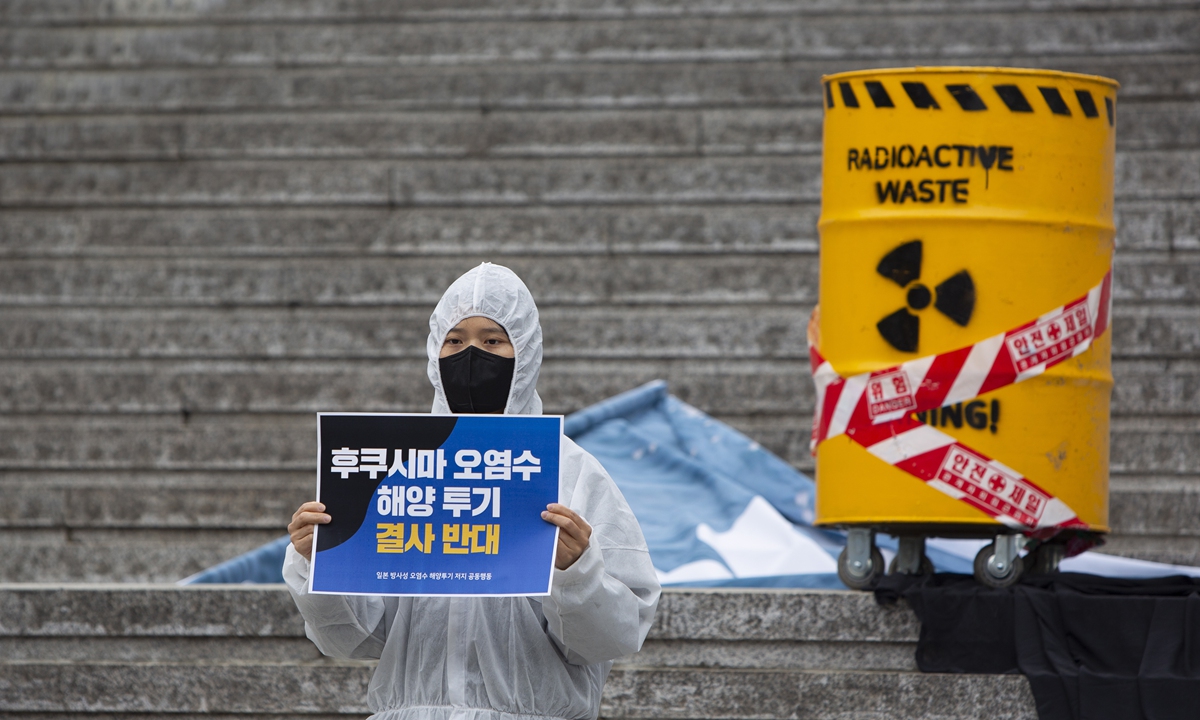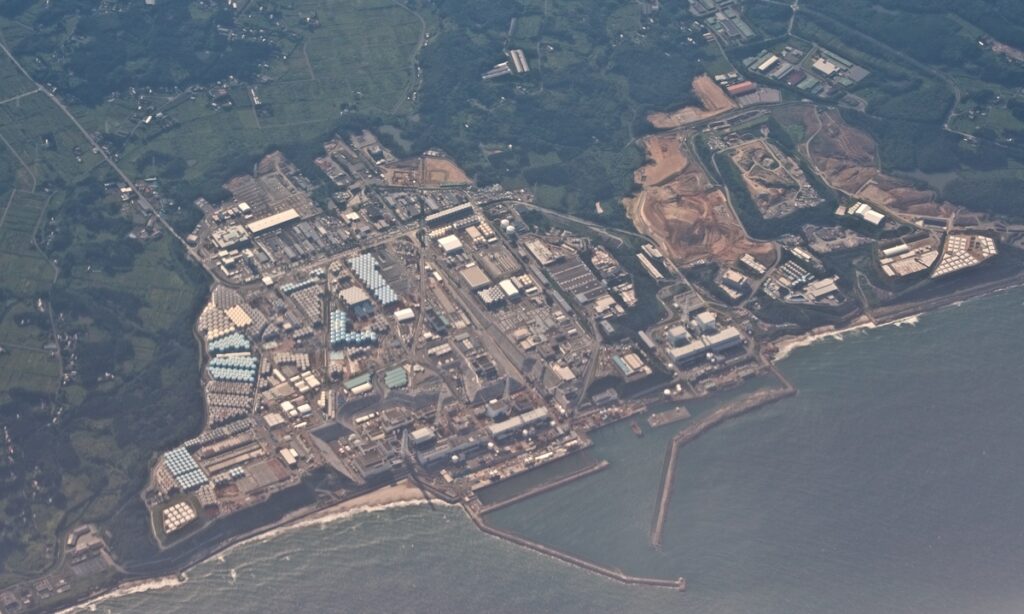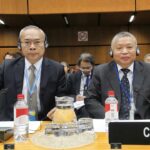Recipe for disaster
As the date for Japan’s planned dumping of nuclear-contaminated wastewater into the ocean approaches, a Pandora’s Box threatening the global marine ecosystem is likely to be opened.
The Japanese government announced its decision on April 13 to release the nuclear-contaminated wastewater from the storage tanks at the Fukushima Daiichi Nuclear Power Plant into the sea. Starting from 2023, the discharge is scheduled to last about 30 years. This decision has garnered widespread attention and sparked great concern across the globe.
While Japanese authorities are busy colluding with some Western politicians in boasting about the discharge plan, Fukushima residents, international experts in ecology, and various stakeholders around the world have kept calling for Japan to reconsider and modify its flawed plan.
Japan’s attempt to “whitewash” the Fukushima nuclear-contaminated wastewater release plan failed again at the Group of Seven (G7) summit in May. The joint statement of the summit did not explicitly state nor allude to the G7 members’ “welcome” of the current dumping plan due to strong opposition. Instead, it only reiterated support for the International Atomic Energy Agency’s (IAEA) review of Fukushima’s treated water release.
An insider familiar with Japan’s dumping plan recently told the Global Times that he has many concerns and doubts about the plan. The insider provided detailed evidence exposing Japan’s lie that whitewashes its dumping plan. He also revealed many loopholes in the plan that the Japanese government and Tokyo Electric Power Company (TEPCO) have refused to talk about or even deliberately concealed from the public.
All provided evidence considered, it is apparent that, currently, Japan is incapable of properly handling the nuclear-contaminated wastewater dumping. The toxic wastewater processed by the Japanese side cannot currently meet international discharge standards, and the country’s reckless behavior, if not stopped and corrected in time, may cause irreparable damage to the global ecosystem.
“There are still many unresolved issues with the source terms of the Fukushima nuclear-contaminated wastewater,” the insider said.
“If the Japanese government and TEPCO continue to have their own way, it may cause improper discharge of nuclear-contaminated water, and that must be taken seriously,” he noted, calling on the two sides to be open, transparent, and honest in solving the problem.
Disappointing data monitoring
Japan’s current plan of releasing nuclear-contaminated wastewater into the sea, though superficially reasonable at first glance, cannot hold up to close scrutiny. Its monitoring on the source terms of the Fukushima nuclear-contaminated wastewater is incomplete, and the data it collects is likely unreliable, observers told the Global Times.
In February 2022, the IAEA Task Force released its first report, the IAEA Review of Safety Related Aspects of Handling ALPS-Treated Water at TEPCO’s Fukushima Daiichi Nuclear Power Station. The report clearly stated that the Task Force “commented on the importance of defining the source term for the discharge of ALPS (Advanced Liquid Processing System) treated water in a sufficiently conservative yet realistic manner.”
Source terms of contaminated water include the composition of radionuclide and the activity of simulation of nuclides dispersion. As the premise of marine environmental monitoring, the accuracy and reliability of the source term-related data is crucial. However, Japan’s data statistics and monitoring on the source terms are disappointingly full of loopholes.
Firstly, the types of radionuclides that TEPCO monitors are relatively few, making it far from being able to reflect the correct radionuclide dispersion in the contaminated wastewater.
The Fukushima nuclear-contaminated wastewater, coming from the wastewater which was directly in contact with the core of the melted reactor, theoretically contains all the hundreds of types of radionuclides in the melted reactor, such as fission nuclides, a uranium isotope, and transuranic nuclide.
But TEPCO at first only listed 64 types of radionuclides including H-3 and C-14 as a (data) foundation for the works including monitoring and analysis, emission control, and environmental impact assessment. These 64 radionuclides did not include the uranium isotope and certain other α-nuclides, which have long half-lives while some are highly toxic.
TEPCO’s exclusion of the radionuclides mentioned above has greatly compromised the effectiveness of its monitoring work, as well as the credibility of its environmental impact assessment result, the insider stressed.
As for sampling and monitoring, TEPCO initially only sampled and monitored nine nuclides in the nuclear-contaminated water except tritium, including Cs-134, Cs-137, Sr-90, C-60, Sb-125, Ru-106, I-129, Tc-99, and C-14 (as well as gross α and gross β).
“TEPCO’s plan of only monitoring a few types of radionuclides is unscientific,” the insider told the Global Times.
Later, during the review process of the IAEA Task Force in 2022, TEPCO changed the number of radionuclide types it was monitoring and analyzing to 30, and then decreased it to 29 this year. This is far from enough to provide a complete assessment of the extremely complex nuclides in the Fukushima nuclear-contaminated wastewater.
Secondly, there are missing activity concentration values for multiple radionuclides in TEPCO’s monitoring scheme.
TEPCO’s public report on the 64 radionuclides only provides activity concentration values for 12 radioactive nuclides other than tritium, while over 50 other nuclides do not have specific activity concentration values. The report, while only offering gross α and gross β values, doesn’t disclose the respective concentration levels of many highly toxic radionuclides in the Fukushima nuclear-contaminated wastewater, such as Pu-239, Pu-240 and Am-241.
“[TEPCO’s] current plan only monitors some of the nuclides and the gross α and gross β values, which cannot accurately indicate the fluctuations or changes in the activity of each nuclide after treating the contaminated wastewater due to the fluctuation of the nuclide source term composition,” said the insider.
This operation of TEPCO has largely increased the uncertainty of the [nuclide] source item information of the nuclear-contaminated wastewater, and thus greatly increases the difficulties of making subsequent monitoring plans and marine ecological environmental impact assessment, he added.
Thirdly, TEPCO didn’t make conservative assumptions in many aspects of its monitoring data, and some of the assumptions it made were somewhat “negligent.”
In the process of treating the nuclear-contaminated wastewater, the slight particle shedding of chemical precipitants and inorganic adsorbents in the ALPS may cause some radionuclides to exist in a colloidal state, the insider explained.
Therefore, TEPCO’s assumption that all nuclides in nuclear-contaminated wastewater in the ALPS are water-soluble is obviously invalid, said the insider. “TEPCO should scientifically and comprehensively analyze whether colloidal nuclides are present in the nuclear-contaminated wastewater based on the long-term operation experience of its ALPS system,” he noted.

A member of a civic group protests against Japan’s plan of dumping nuclear-contaminated wastewater, in Seoul, South Korea, on April 25, 2023. Photo: IC
Incompetent wastewater treatment
There are two main sources of Fukushima nuclear-contaminated water. One is the cooling water continuously injected into the core of the melted reactor to prevent the core from further melting. The other is the wastewater generated when the rains and groundwater coming into contact with radioactive materials in the melting reactor.
The nuclear-contaminated wastewater is collected and sent to the ALPS for treatment. After being treated, the wastewater is stored in tanks at the Fukushima nuclear power plant site. Currently, more than a million tons of nuclear-contaminated wastewater has been accumulated in these tanks.
Can the nuclear-contaminated water meet the discharge standards after the ALPS treatment? The answer is probably no. The effectiveness of TEPCO’s ALPS may not be as good as some optimistic Japanese and Western politicians may have imagined, the insider told the Global Times.
He pointed out that Japan’s existing ocean discharge plan and evaluation are based on the assumption that the nuclear-contaminated wastewater can meet discharge standards after treatment. But unfortunately, the data released by TEPCO showed that as of September 30, 2021, some 70 percent of the then 1.243 million cubic meters of ALPS-treated nuclear-contaminated wastewater still failed to meet the criteria, 18 percent of which even exceeded the standards 10 to 20,000 times over.
The Japanese government claims that in the early stages of the Fukushima nuclear-contaminated wastewater treatment (2013-2019), the effectiveness of ALPS was limited due to reasons such as rudimentary technology, leading to the treatment of certain nuclides being particularly unsatisfactory.
For instance, TEPCO reports said that the efficiency of ALPS in treating Sr-90 was extremely unstable. The activity concentration range of Sr-90 in the Fukushima nuclear-contaminated wastewater was relatively large after ALPS treatment. The activity concentration of Sr-90 in some of the water reached 104 Bq/L, far exceeding the discharge concentration limit (30 Bq/L).
The frequent malfunctions of and component damage at ALPS also raised doubts about its competence as a nuclear-contaminated wastewater treatment authority.
On August 24, 2021, an alarm was sounded in the treatment system when staffers were transferring sludge produced by ALPS to other containers. A following investigation found there were at least 10 breakages on the filters used to adsorb nuclides.
To replace the filters, all the ALPS equipment stopped working from August 30 of that year. TEPCO later discovered that 24 of the 25 filters on the ALPS equipment were damaged.
On September 21, 2021, TEPCO announced that five more filters in ALPS were found to be damaged, and radioactive contamination had been detected near some of the filters.
Would the situation then improve if the undertreated water undergoes a second round of ALPS treatment? “The answer is still unknown,” said the insider. He added that the discharge plan provided by TEPCO neither explained how to ensure the nuclear-contaminated wastewater would meet discharge standards after treatment, nor did it include an impact analysis of the substandard water discharge.
“So far, TEPCO has only dealt with 0.25 percent of the nuclear-contaminated wastewater with a second round of treatment. It hasn’t disclosed a timeline for the second round of treatment [for all the undertreated wastewater], nor has it ever publicized a plan on it,” he told the Global Times. “TEPCO’s passive attitude has chilled the heart of all the parties in and out of Japan who are concern about the discharge.”
Irresponsible, untrustworthy TEPCO
Established in 1951, TEPCO accounts for one-third of Japan’s electricity generation, with its grid covering Tokyo and eight neighboring prefectures. This industry giant is however infamous for its spotty history. Over the last few decades, issues of misconduct at TEPCO have been exposed by the media including the falsification of safety inspection records of nuclear power plants, and concealing nuclear power plant accidents.
In the data monitoring and treatment of the Fukushima nuclear-contaminated water, TEPCO has been widely criticized for the neglect of duty, concealing important information and shirking responsibility.
After the ALPS filter damage incident in 2021, TEPCO representatives admitted that the company had neglected to investigate the cause of the filter failures. TEPCO said it had discovered similar damages on filters two years ago, but it had neither investigated the cause of the problem nor taken any preventive measures other than simply replacing the filters.
A member of the Japanese Nuclear Regulation Authority once stated that there were serious problems within TEPCO’s management. In addition to the filter damage, TEPCO’s attitude is what has fundamentally led to numerous problems. TEPCO should have responded quicker to this accident to minimize the risk of radioactive materials leaking into the environment.
“The series of falsification issues that have occurred in TEPCO indicate that the company does not attach enough importance to safety, and the data it provides is not trustworthy,” the insider told the Global Times.
The insider added that there are still many unresolved issues in the decision of discharging Fukushima nuclear-contaminated wastewater into the sea considering TEPCO’s attitude and other factors. In order to ensure that the discharge is reasonable and feasible, and that the impact on the marine ecological environment and human health can be minimized, he urged the Japanese government and TEPCO to carry out the following works.
Firstly, Japan should fully disclose the source item information of nuclear-contaminated wastewater to the international community, especially its neighboring countries.
Japan should conduct more comprehensive monitoring and scientific analysis, to fully know the compositions and activity levels of the nuclides in each storage tank, as well as the characteristic information that has an important impact on the safety after discharging the wastewater into the sea. These are some efforts Japan must make to truly know how many radioactive materials will be actually dumped into the sea.
Secondly, Japan should improve its discharge plan. It should monitor all the required nuclides, conduct further research on the defects and the shortage of reliability of the ALPS, and design a detailed plan for the second round of nuclear-contaminated wastewater treatment. The discharging work should not be carried out until these issues are resolved.
Thirdly, Japan should fully evaluate the long-term and uncertain hazards of nuclear-contaminated wastewater when deciding the plans of dealing with the contaminated wastewater.
“Moreover, Japan should not view dumping the wastewater into the sea as the only option,” the insider noted. Japan should also consider other more feasible and safer options for the disposing of the Fukushima nuclear-contaminated wastewater, such as evaporating it into the atmosphere, he suggested.
(Global Times)




